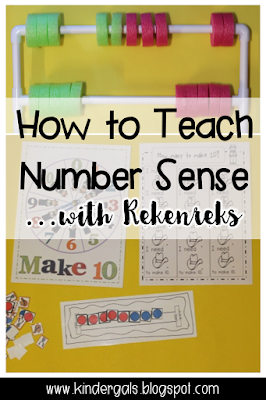This is a rekenrek…just in case it’s a new term to you. When we started common core, a rekenrek was one of the new tools I learned how to use. They aren’t new, I just had never used one before. You can learn a lot about where they came from and how they can be used just by using Google!
I saw this idea on pinterest to make a large teacher sized one. It is made with pvc pipe and pool noodles! So, you guessed it….Andy had to make me one…along with about 6 others for friends that put in their orders. The small white card, is the student sized one!
Here are a few things about Rekenreks….

To use them…Always start with all the beads pushed over to the right. The kiddos push their answer over to the left. Then, they are able to read their answer from left to right.

So while I was in Chicago last week, my friend Kathleen wanted me to model how to use them. Now here’s the tricky part…she has a smart board! I never used one when I had my own classroom so this was an opportunity to try it out. I can’t believe it, but I made a smart board lesson for teaching the rekenrek. It was super funny to make and do. I had made the slides the night before. The next morning, My friend Kath and I each had a pen and were both trying to add the “movable” shapes at the same time, each of thinking we knew how to do it best!!! We finally got a much younger teacher who was able to show us our simple mistake and we got it all done! Then, during the lesson I used the tool to drag over the shapes and write the numerals. Can I say, I was just a little impressed with myself?

It doesn’t take much, I am so challenged when it comes to technology!
First I modeled how to move all the beads to the right side of their card. (Each of the children had their own card.)
We were working on whether an equation was true or false. (This is a first grade common core standard.) So first I made an addition sentence and we moved the beads to the left to figure out the sum. Then, we put another addition sentence after the = sign and moved the beads on their cards to the left to figure out that sum. Were the sums equal? We did start with “turn arounds”, commutative property, as they had been working on those and I thought it would be an easy place to start.
In my lesson, I had made the first addition sentence using both rows, then the kiddos made the second addition sentence using both of their rows. We compared the sum on their cards to the sum on the smart board.
One teacher suggested having them do the first addition sentence on the top row and the second addition sentence on the bottom row and it would be easier for them to compare the sums! Totally makes sense! (Teachers from Kath’s school were observing while I was doing the lesson.)
The way I did it helps them to see the different equations and her way would help them see the sums…so that would be 2 different lessons!
Then, it was time for Math Centers and Small Groups. I pulled a small group to do a different rekenrek lesson---Make a 10. Here the kids in the small group each had a rekenrek.
Then, we would spin the spinner. Whatever numeral it lands on, the children move that many beads over to the left. Now look at the beads on the right side and that is how many to make a 10! This activity is from my
Yeehaw! Wild About Numbers! Unit. (Not the smart board, just the small group lesson.) We practiced, conceptually a few times, then we started writing our combinations on the recording sheet.
Thanks to the teachers at Morton Gingerwood! You were a great bunch to work with…I know good things are going to happen in your school because you were eager, reflective, and fun!
 We made a paper plate leprechaun and wrote a how to piece for How To Catch a Leprechaun.
We made a paper plate leprechaun and wrote a how to piece for How To Catch a Leprechaun.








































































